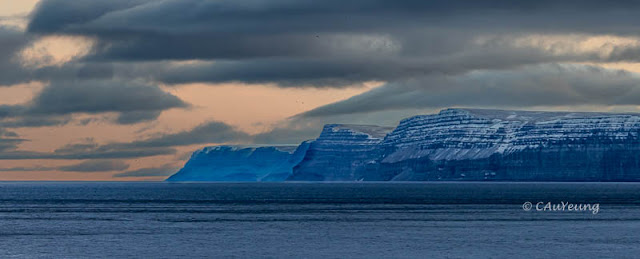Continuing our journey north from Gjoa Haven, we travelled through the Franklin Strait to Coningham Bay, on the southeast coast of Prince of Wales Island. The bay is very shallow and there is a large sandbar across its entrance that nearly encloses it at low tide. The richness of the waters here made it an ideal feeding ground for beluga whales but at the same time made them prime targets for polar bears when they are trapped by low tide. It was therefore no surprise that when we arrived in the bay, we saw a polar bear family feasting on the carcass of a beached beluga. I was surprised though that the bear cubs were also feeding on the carcass, at least there was blood on their faces.
 |
Polar bear family at beluga whale carcass |
The expedition team reported a total of 12 bears that morning plus one dead one. Except for the ones near the shore, the others were quite far away and difficult to photograph.
 |
| The one dead bear was very unusual, according to the Inuit couple on board, they have never seen one all these years. |
Great care was taken to protect us from polar bears. Whenever we go on shore, scouts were sent ahead to make sure there are no bears around and bear guards establish a perimeter within which we are safe. We are not allowed to wander beyond that perimeter. As we were going into the bay, each zodiac has a rifle just in case, afterall we did see a bear go into the water.
 |
| Sunset as we sailed through the Bellot Strait |
Cairn on south shore
After Coningham Bay (5) and the Bellot Strait, we travelled north along Prince Regent Inlet to Port Leopold. Port Leopold is an abandoned trading post and is the site of the first winter camp for the first major Royal Navy search for Sir John Franklin's missing expedition. We were originally going to have hikes at Port Leopold, but the scout sighting of polar bears meant we had to cancel most of the hikes, including the hike to the Hudson Bay Trading Post. It's a good thing we were able to see it from the ship (with a long lens!). We did see the remains of a Thule settlement, with remains of whale bones which were used in their construction. The Thule culture were the ancient predecessors of the Inuits.
 |
| Ruins of Thule house |
 |
Whale bones at the Thule sites. Whale bones are used in the construction of Thule houses and their placement had a certain symbolism within the culture. |
 |
| Hudson Bay Trading Post |












No comments:
Post a Comment